Told in four chapters, La Poule aux oeufs d'or; aka, La Gallina de los huevos de oro. (1905) is a revisioning of the tale of "The Chicken That Laid the Golden Eggs," in a highly imaginative silent film in full color thanks to state-of-the-art hand-tinting of each frame one by one.
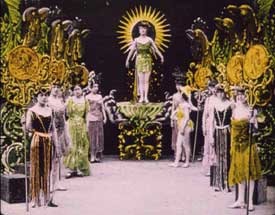 Many films were hand-tinted in this era, but most of them were only one to three minutes long because of the labor-intensive nature of the work. Director Gaston Velle had as his director of cinematography & special effects artist the Aragonese FX pioneer Segundo de Chomon, whose delight in full color required such fantasies be given the full treatment. Many films were hand-tinted in this era, but most of them were only one to three minutes long because of the labor-intensive nature of the work. Director Gaston Velle had as his director of cinematography & special effects artist the Aragonese FX pioneer Segundo de Chomon, whose delight in full color required such fantasies be given the full treatment.
In the second-long title scene, we are shown a red chicken who sits on golden eggs. Then begins Chapter One, titled in the Spanish copy I watched A Loteria de Hanchicero. In a medieval setting, a magician stands on an outdoor stage performing. He uses a wheel-of-fortune device to produce prizes for the eager audience, & a young man wins a chicken.
We then see a young woman in a little courtyard feeding her chickens. Her husband returns with one of hte prize birds from the magician's lottery. She puts the chicken in the henhouse with her other hens.
Chapter Two is El Gallinero Fantastico. The maiden of the hens (played by Julienne Mathieu, the wife of Chomon the cinematographer & FX director) goes to check her hens & eggs.
She finds that the new prize chicken has laid a golden egg. She runs off in a dither of delight to tell her husband. In her absence the golden hen turns into a maiden in a golden feathered bathing suit. She turns the other hens into maidens in black-feathered bathing suits & they dance for her.
The henhouse turns into a wonderful magical environment suitable for fairy chickens. The golden hen-maiden does a ballet then leads a rooster out of the henhouse & turns him into a pile of enormous eggs.
The husband & wife have by now returned to the henhouse which has transformed itself back to normal, except for the giant eggs are stacked underneath the prize hen.
The husband cracks open one of the huge eggs & poors golden coins out of it. All the eggs are full of coins! The husband kisses & strokes the magic hen.
We're introduced to two new characters, sneak-thieves who creep into the hen yard where they find & bag a rabbit before they are discovered & kicked out, the rabbit still in their sack. Luckily they did not yet learn the secret of the eggs of gold.
Chapter Three is Fortuna Efimera. We now see our husband & wife in a rich palace dressed in finery. The magic hen resides in a fancy bird cage.
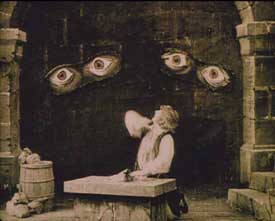 The two sneakthieves return through the ornate window & take a giant egg the hen has just laid, but when they break it open, a bat flies out & away. The two sneakthieves return through the ornate window & take a giant egg the hen has just laid, but when they break it open, a bat flies out & away.
The next egg has a devil's head on it. When frightened they throw it on the floor, it bursts into a cloud of smoke.
The husband comes into the room & the thieves hide behind decorative suits of armor. They see him take one of the hen's eggs, taking it through a secret door in the floor, to a treasure room. There he empties the egg of its coins.
In a moment of paranoia, the husband sees giant eyeballs staring at him from the wall. Then disembodied arms try to grab his money. He greedily plays with the coins trying not to have his joy ruined by his fears.
When he leaves the secret room, the thieves soonafter open the floor-door to check things out for themselves. They steal bags & bags of coins then flee by the window.
At dawn the husband & wife find the floor-door open & their money stolen. Bill collectors arrive immediately, dismissed unpaid.
Desparate for the hen to lay replacement eggs full of gold more quickly than is possible, the husband is even willing to carve her open to get the gold out of her.
The closing Chapter Four is El Castigo de Avaro Opoteosis. In the barn, the husband oh so foolishly slays the chicken & of course there is no gold inside her.
The devil appears momentarily as though victorious. What will turn out to be the spirit of the hen appears as a raggedy woman. She turns the barn into a fairyland of giant eggs of gold, out of which hatch beautiful fairy maidens, & the ragged woman is herself now the golden-feathered chicken-fairy.
The women drag the husband away, to what fate we aren't shown, but it doesn't seem likely to be a happy end for him, though luckily killing the hen did not kill the chicken-fairy herself.
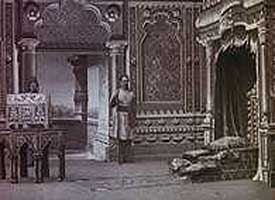 Hand colored by the Pathe stencil set method, The Rajah's Casket (L'Ecrin du Rajah or L'Ecrin du Radjah, 1906) was a French/Italian production.
Hand colored by the Pathe stencil set method, The Rajah's Casket (L'Ecrin du Rajah or L'Ecrin du Radjah, 1906) was a French/Italian production.
It can be found on volume one of Retour de Flamme from Lobster Films in France, a fabulous multivolume dvd set of early short films & cartoons mostly from France, America, & Italy, for which you'd need a region-free dvd player to enjoy it in America.
The Rajah's Casket is also the first film in an on-line collection called Collected Works of Segundo de Chomon, & if you do a google search you should be able to find the stream-video at a couple locations.
Not everything in the string of videos is by Chomon, & this one is properly credited as directed by Gaston Velle, but written, photographed, & with special FX by Chomon means he should be regarded as co-director.
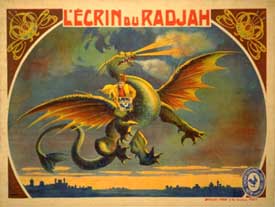 Both Gaston Velle & Segundo de Chomon worked hard under the influence of Georges Melies. Velle on his own tended to be a weak imitator of Melies. Both Gaston Velle & Segundo de Chomon worked hard under the influence of Georges Melies. Velle on his own tended to be a weak imitator of Melies.
For example, in Velle's stencil-tinted The Flower Fairy (La Fee aux fleurs, 1905) he recreates a Meliesian situation. A damsel begins building a frame around herself out of flowers, & ultimately turns even herself into flowers.
Melies could easily have made it except it would've been better. Velle made the "Hallmark Card" equivalent of what Melies could do as a genuine rather baroque artist.
Chomon on the other hand often added something of his own so that his Melies-esque films were of a higher quality. And when he lent his skills as an FX engineer & director of photography to Velles films, they were both pushed to finer heights.
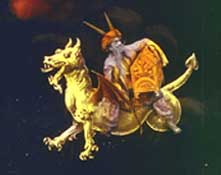 A lush moorish or turkic-inspired set design & gorgeous costumes makes The Rajah's Casket a visual thrill. Sundry characters gather before the young rajah, presenting him with gifts, including a casket or treasure chest which is soon stolen by means of magic.
A lush moorish or turkic-inspired set design & gorgeous costumes makes The Rajah's Casket a visual thrill. Sundry characters gather before the young rajah, presenting him with gifts, including a casket or treasure chest which is soon stolen by means of magic.
A fakir is brought forth who does some sword & fire magic to help uncover the culprit who stole the treasure chest. The fakir leads the Rajah to a room with an enormous window, through which a horned djinn is seen flying by on a smoke-billowing wyvern, clutching the stolen casket.
Investigating through a forboding ruin, the fakir & the rajah come upon the djinn's cavern. The rajah draws his sword & destroys the djinn. In the next chamber of the cavern they find the treasure chest, from which arises a beautiful queen dressed in gold & six dancing girls in green. They put on quite a colorful performance, showing a lot of thigh from under their long dresses.
The treasure chest is brought to the rajah's palace where the rajah is enthroned with the queen, the maidens dance joyfully, & the vizier discovers the chest also has jewels within.
copyright © by Paghat the Ratgirl
|
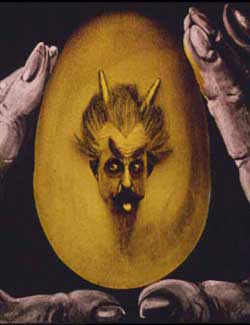
 Many films were hand-tinted in this era, but most of them were only one to three minutes long because of the labor-intensive nature of the work. Director Gaston Velle had as his director of cinematography & special effects artist the Aragonese FX pioneer Segundo de Chomon, whose delight in full color required such fantasies be given the full treatment.
Many films were hand-tinted in this era, but most of them were only one to three minutes long because of the labor-intensive nature of the work. Director Gaston Velle had as his director of cinematography & special effects artist the Aragonese FX pioneer Segundo de Chomon, whose delight in full color required such fantasies be given the full treatment. The two sneakthieves return through the ornate window & take a giant egg the hen has just laid, but when they break it open, a bat flies out & away.
The two sneakthieves return through the ornate window & take a giant egg the hen has just laid, but when they break it open, a bat flies out & away.
 Both Gaston Velle & Segundo de Chomon worked hard under the influence of Georges Melies. Velle on his own tended to be a weak imitator of Melies.
Both Gaston Velle & Segundo de Chomon worked hard under the influence of Georges Melies. Velle on his own tended to be a weak imitator of Melies.